Estimated reading time: 18 minutes
There are many reasons why someone would plant a row of shrubs along and around their property. A lot depends on where you live and your location within any area.
People living in rural areas will sometimes plant a hedgerow of privacy shrubs and even closely spaced rows of trees to mark their property, discourage trespassers, and even keep out wildlife.
People living in suburban and urban areas will often plant privacy shrubs to simply enjoy a summer evening on their deck or in their backyard without the constant watchful eyes of nosey neighbors.
In some instances, people plant a row of shrubs for more than privacy including added security either as a physical barrier to entry, or to simply keep a house, out-building, or other valued piece of property out of sight and out of mind.
Want to save this post for later? Click Here to Pin It On Pinterest!
Why Not Just Put Up a Fence?
A fence is always an option, but they can be expensive; in some instances unsightly, and require maintenance from staining or painting to replacements of slats or rotting of support beams in the ground.
That’s not to say a hedge of shrubs is maintenance free, but natural designs may be simpler and less expensive in the long run. More to the point, a hedge of shrubs looks better in the eyes of anyone who can see it.
Fast-Growing is Important
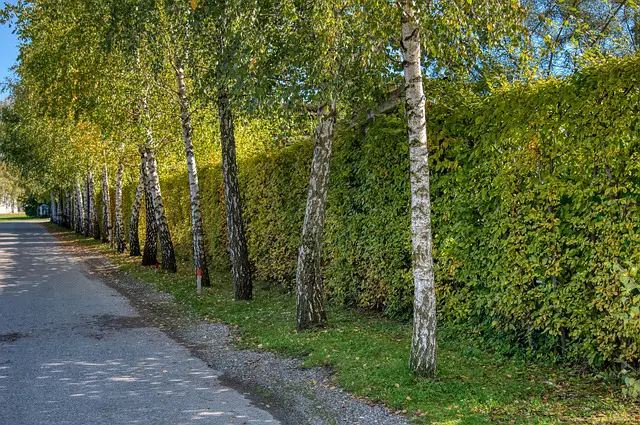
Most plants don’t grow quickly. Especially trees and shrubs. They increase in size over time, and it can often take years for some shrubs and trees to approach any appreciable size. That’s a problem if you’re trying to plant shrubs for privacy or security.
Fortunately, there are some species of shrubs that can grow as much as 2 to 3 feet a year. That’s important if you’re depending on a plant to block a view or create a barrier. It still won’t happen overnight, but in a couple of years you should have good results.
A lot depends on the size of shrub you buy in addition to the species. You can buy privacy shrubs online, but if you want a fast start, you can often find larger shrubs at a local nursery.
Another factor affecting rapid growth is proper planting, feeding, and watering. That sounds easy enough, but if your privacy shrubs are some distance away from a watering hose, or the rows are very long, both feeding and watering can be a challenge.
For that reason, we’ll focus on hardy shrubs that are somewhat drought-tolerant and don’t fall in the category of heavy feeders. These shrubs also grow quickly and densely, so you may have some of the benefits sooner rather than later.
Shrub Planting 101
Most commercially purchased shrubs either come in a large pot or are contained in a root ball wrapped in canvas and tied with a biodegradable rope. The tendency at times is to assume that the hole you dig for the shrub needs to be the size of the pot or root ball. That’s a mistake.
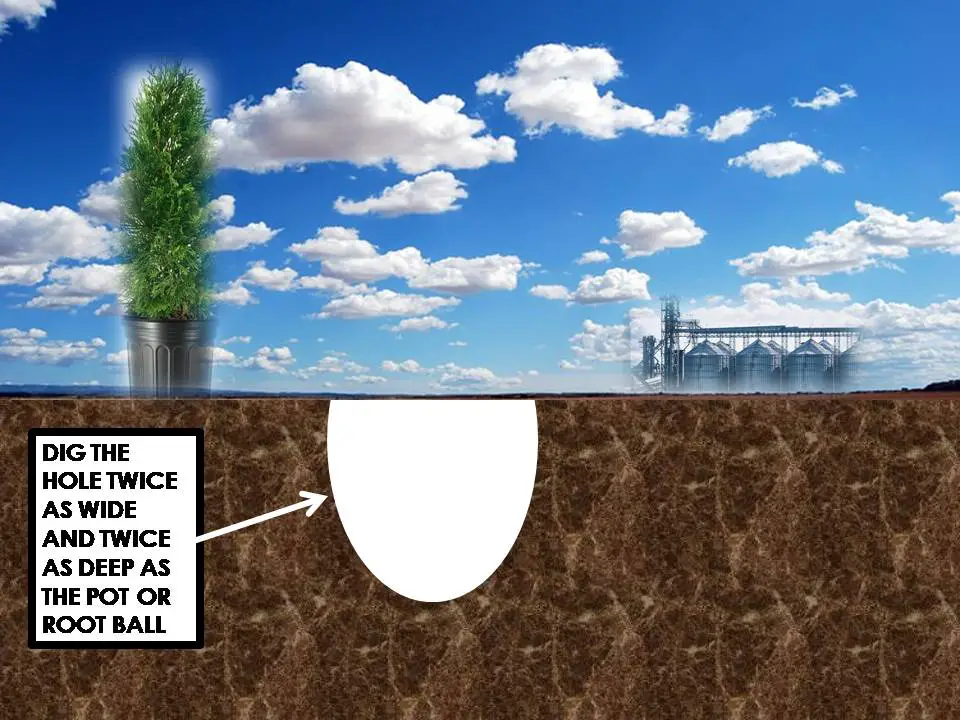
The hole should actually be at least twice the size of the root ball or bucket. Twice as wide and twice as deep. But planting it is not that simple. You should never dig a hole twice as deep as the root ball and simply drop it into the ground. The base of the trunk where it meets the soil needs to be at ground level.
That means that you need to refill the hole with additional soil before planting.

It seems counter-productive to dig out a lot of soil and then refill the hole to adjust for the depth, but there’s a problem with most soils.
After digging through the topsoil, it’s inevitable that you’ll hit a clay layer. Clay is not exactly a nutrient dense environment, and it’s not an easy type of soil for new roots to penetrate. Clay is the biggest reason you’re digging your hole wider and deeper for your root ball.
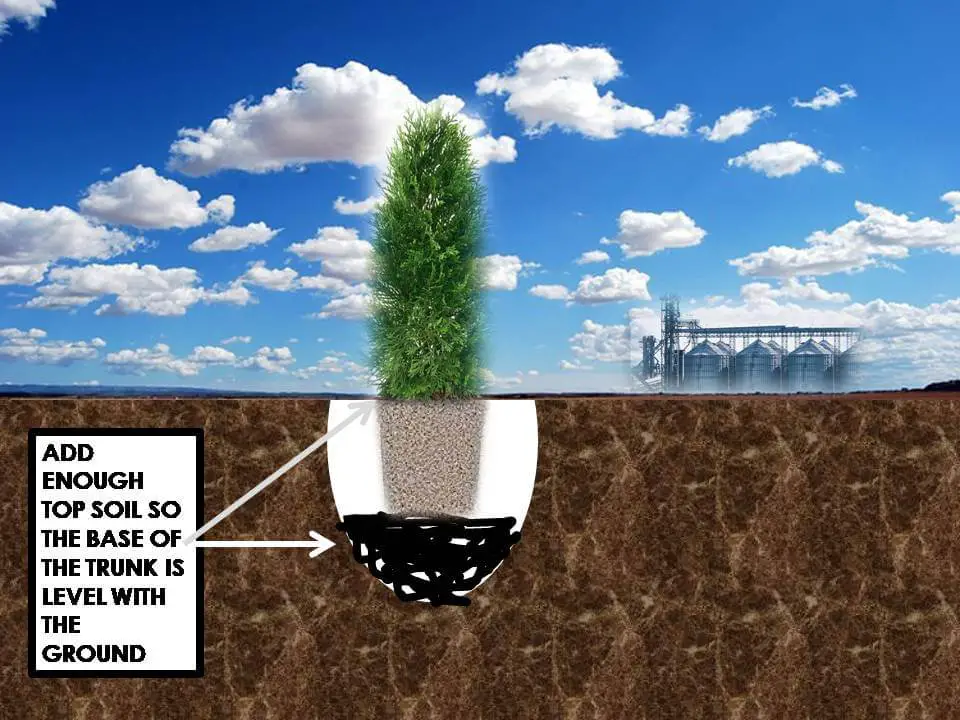
As a result, the first step after digging the hole is to refill the hole with enough topsoil to allow the top of the root ball to be at ground level. You use topsoil because it's dense enough to support the weight of the root ball over time.
A lighter mix to surround the root ball is a combination of soils including peat and compost that is not as dense, but it can compact, causing the root ball to sink. If the base of the tree ends up too deep below ground level, it can kill the shrub. Make sure there’s enough soil to keep the top of the root ball level with the surface.
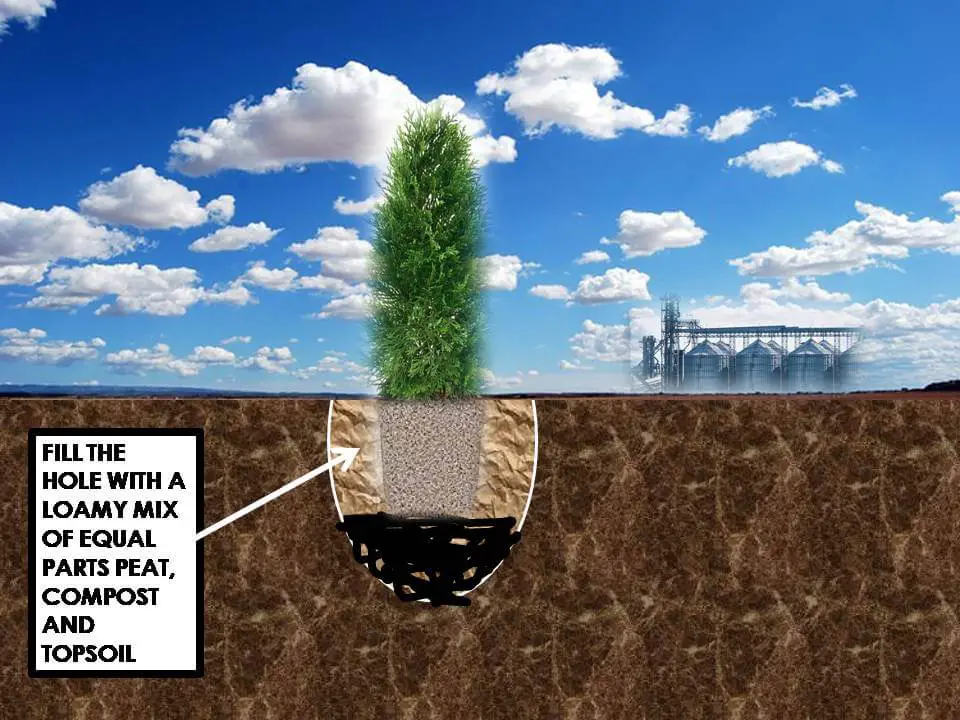
Once you have your root ball centered in the hole, surround it with a loamy mix of 1 part peat moss, 1 part compost, and 1 part topsoil. This will help feed the new shrub while retaining moisture and encouraging root growth.
If the root ball is wrapped in canvas, you can leave the canvas on the root ball but cut out the canvas around the top of the root ball once it’s in the hole and cut any ropes binding the root ball. The rope ends can be left in the hole where they will eventually decompose, but it’s especially important to loosen up that canvas at the top and cut any ropes.
As you fill the hole, tamp down the loamy soil mix. It easily compacts, so you want to make sure it doesn’t settle, leaving the top edges of the root ball exposed. You could water the soil in the hole halfway through refilling to work it down. Step on it and tamp it down a bit as you approach the surface and refill until you have leveled the soil in the hole with the surface.
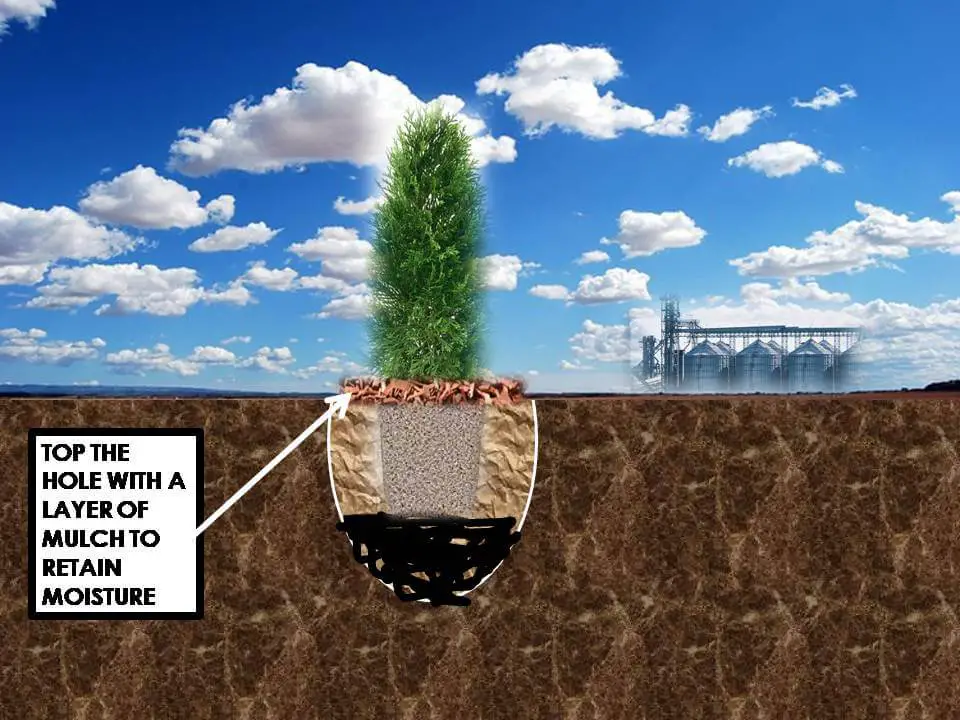
Finally, top the soil with a mulch. Wood chips, bark, stone, or any other type of mulch that will prevent evaporation. Once the mulch is in place, give the shrub a good watering. In fact, go back after a few minutes and water it again. When any plant is replanted or planted for the first time, it’s in shock. Water helps the plant to recover.
Continue to water at least twice a day for about a week. Morning and evening is best. Hopefully you have some rain to keep things going but the first week is critical to the long-term health of any tree or shrub newly planted.
Evergreen or Deciduous?
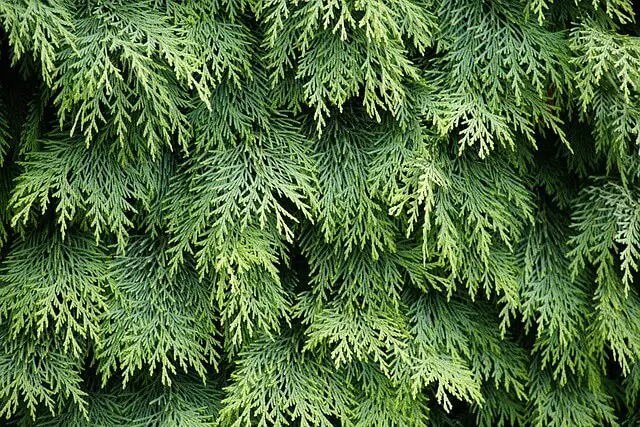

The benefit of evergreen shrubs is that you will have the same level of privacy all year-round. Deciduous shrubs lose their leaves in the fall, and while some shrubs develop a fairly thick branch structure over time, they don’t provide the same level of year-round privacy as an evergreen shrub.
A lot depends on when and why you’re planting a hedge row of shrubs. If you simply want to enjoy some privacy while outdoors during the summer, a deciduous row of shrubs will work fine. If you want year round privacy or simply can’t stand staring at something next door or across the street, evergreen shrubs are the way to go.
The Importance of Hardiness Zones
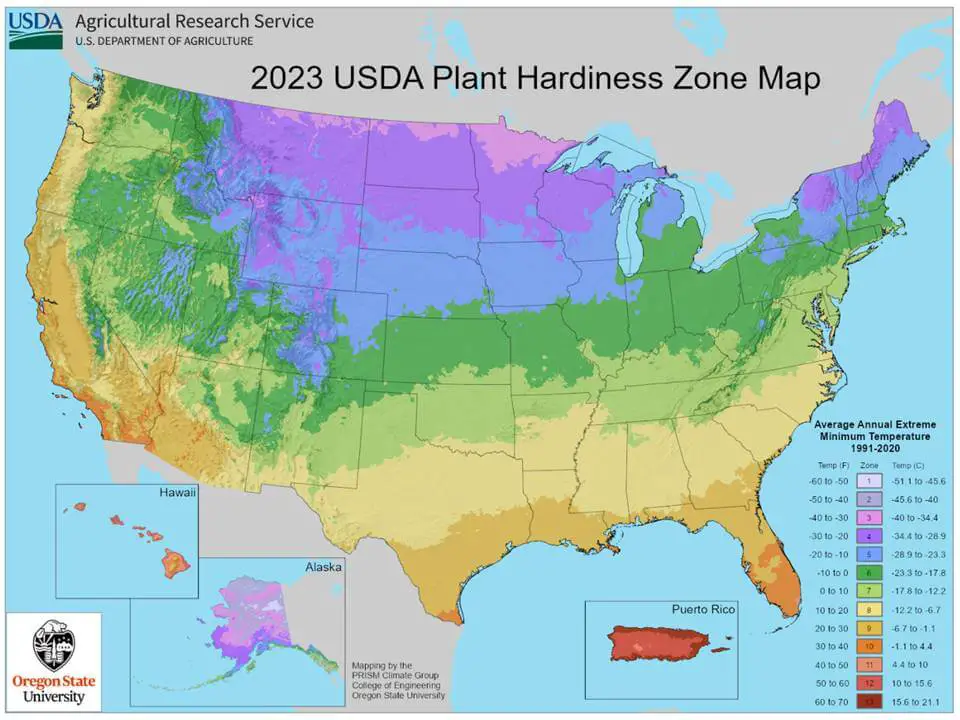
North America is broken up into a series of zones determined by average temperatures. The higher the number, the warmer the temperatures. To make this easier, we’ll focus on shrubs that will survive and thrive in a range of zones.
Take the time to look at the hardiness zone where you live if you want to locate and buy alternative shrubs that will tolerate weather extremes in some of the zones with very high or very low temperatures.
The 8 Best Shrubs for Privacy
Like so many things, there are various considerations for selecting a shrub variety for a privacy hedge. A lot has to do with what you’re trying to accomplish. Here are some of the reasons someone might plant a privacy hedge on or around their property and the best shrubs to achieve that specific goal.
Privacy Obstruction
This is the most fundamental reason for a privacy hedge. It’s to obstruct the view of something. In some instances, you don’t want to sit in your backyard and constantly be confronted by the growing mess in your neighbor’s backyard.
At other times, you may want to obstruct something in the distance that is simply unsightly like a shopping mall across the street, or some other building or structure that’s unsightly or just ugly to look at.
Then again, some people want to obstruct the view of their home or an outbuilding or even a garden simply to keep potential trespassers unaware, away, or at bay. With that in mind, here are two shrubs often touted as the best varieties for fast-growing privacy:
1. Arborvitae Emerald Green (Thuja occidentalis) – Evergreen

Arborvitae is one of the most common shrubs used for privacy hedges. It’s low maintenance and grows into a thick wall of shrubbery.
- Mature Height: 12–20 feet tall, 3–10 feet wide
- Special Features: Very hardy and the most popular shrub for privacy hedges. Prefer full to partial sun and moist but well drained soil.
- Hardiness Zone Range: 2 to 7
- Maintenance: Low maintenance but requires pruning to manage height and width over time.
2. Burning Bush (Red Euonymus)– Deciduous
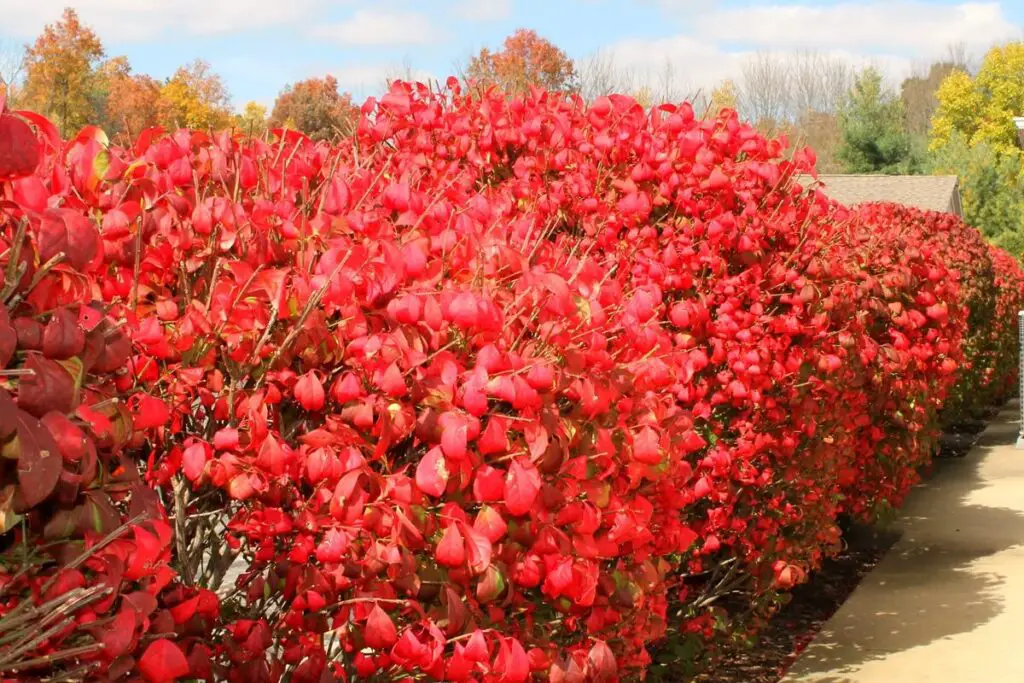
A hedge of burning bushes is a common sight in many yards. They prefer full to partial sun and grow in close proximity without complaint.
- Mature Height: 3-20 ft. tall, 3-12 ft. wide
- Special Features: Turns bright red in the Fall. Can be somewhat invasive as birds eat and spread the seeds. Known to contain alkaloid compounds that are mildly toxic.
- Hardiness Zone Range: 4 to 8
- Maintenance: Prefers moist soil, very hardy. Prune to control to suit your needs.
Privacy and Security
In some instances it’s about more than obstructing the view but keeping people out of an area. This could be as simple as making a backyard more secure, or securing a distant part of your property.
The density of a hedge row of shrubs is one way to deter entry to an area, but we’ll also look at shrubs with thorns as a deterrent. Here are two shrubs that have historically offered both privacy and security:
3. Common Holly (Ilex aquifolium) – Evergreen
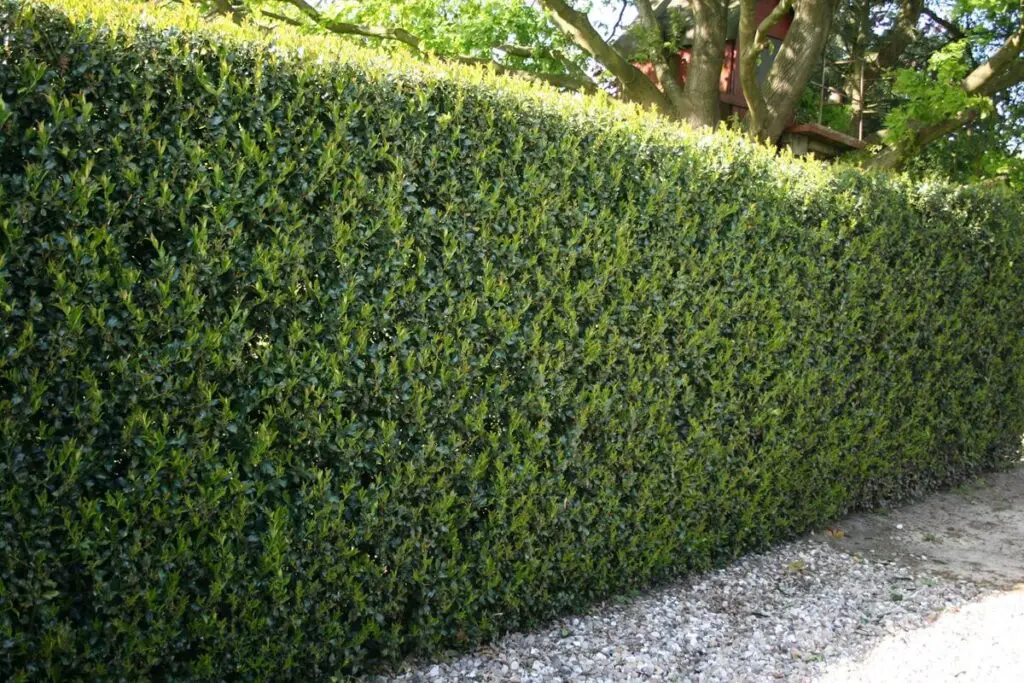
Holly is typically associated with Christmas, but if you’ve ever seen a holly bush, you may notice there’s not much merry about it. Its shiny, green, and leathery leaves have sharp needles protruding that will both puncture and scratch the skin. They’re also evergreen plants and grow densely, providing both privacy and security.
- Mature Height: 10 to 12 feet high and 8 to 10 feet wide.
- Special Features: Fast growing and low maintenance. Tolerant of moist soil conditions and prefers moist soil. The red berries are highly toxic.
- Hardiness Zone Range: Zones 5 to 9
- Maintenance: Pruning is necessary to manage the width of the plant.
4. Wild Roses (Rosa Virginiana) – Deciduous
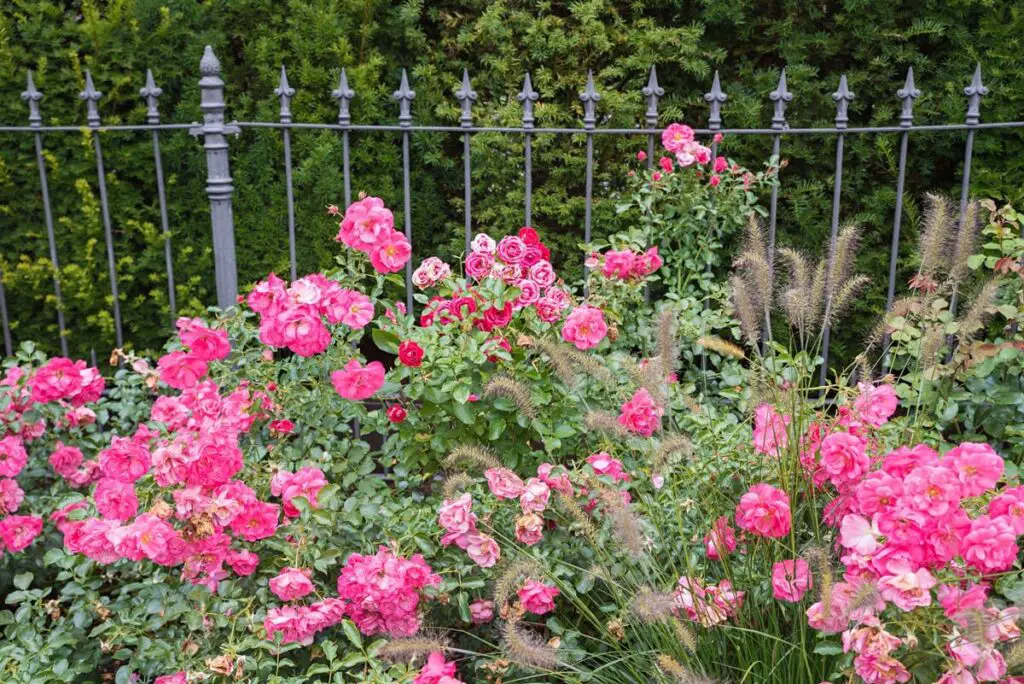
We typically think of roses as bushes, but wild roses grow long canes and as a shrub can grow up to 6 feet high. The width spreads as a bramble and the combination of their leaves and flowers plus the added security of their thorns make for an effective privacy screen that few will attempt to walk through.
Better yet, many wild roses are fast growing and as an indigenous plant are very hardy. They prefer full sun and partial shade and a sandy, loamy soil. On a side note, many wild foragers know the rose hips of the wild rose are one of the best natural and wild sources of Vitamin-C and the hips can easily be replanted to extend the size of the hedge.
- Mature Height: 3 to 6 feet high and up to 8 feet wide
- Special Features: Flowers typically have 5 petals and are pink.
- Hardiness Zone Range: Zones 3 to 8
- Maintenance: Roses love water and while wild roses are more drought tolerant they thrive in a moist soil with good drainage. Pruning can help control the width of any wild rose hedge.
Aesthetic Privacy
Privacy hedges aren’t always the most attractive feature on a property, but there are options that are not only functional but pleasing to the eye. The trade off is that they are sometimes not as hardy as an Arborvitae or Burning Bush, but with at least some attention can survive and thrive for years and years.
5. Border Forsythia (Forsythia x intermedia) – Deciduous
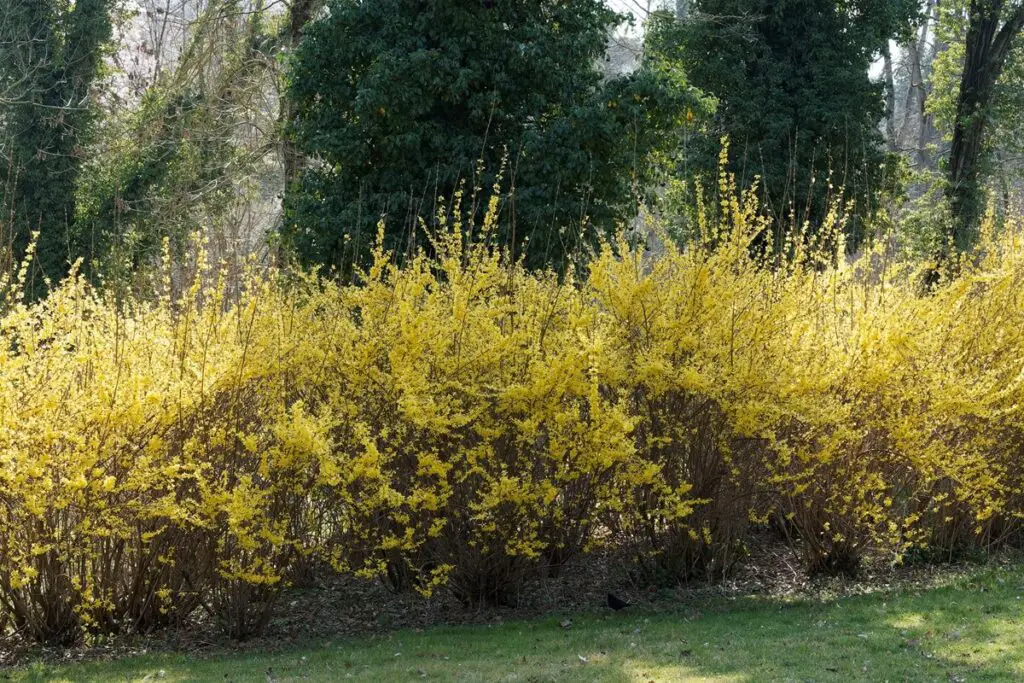
When considering a shrub for privacy it’s encouraging when the plant has the word “border” in its name. Border Forsythias have been used for centuries to define borders and provide privacy. They’re deciduous so you won’t have as much privacy in winter, but their yellow blooms make up for that if you’re only looking for some privacy in summer.
Forsythias are hardy plants and cuttings propagate easily. They’re low maintenance requiring only occasional pruning and grow well in close proximity.
- Mature Height: 8 to 20 feet
- Special Features: Prefers full sun to part shade
- Hardiness Zone Range: Zones 5 to 8
- Maintenance: A very hardy shrub that will grow in all soil types. Pruning is recommended to manage height.
6. Photinia (Photinia x fraseri) – EVERGREEN
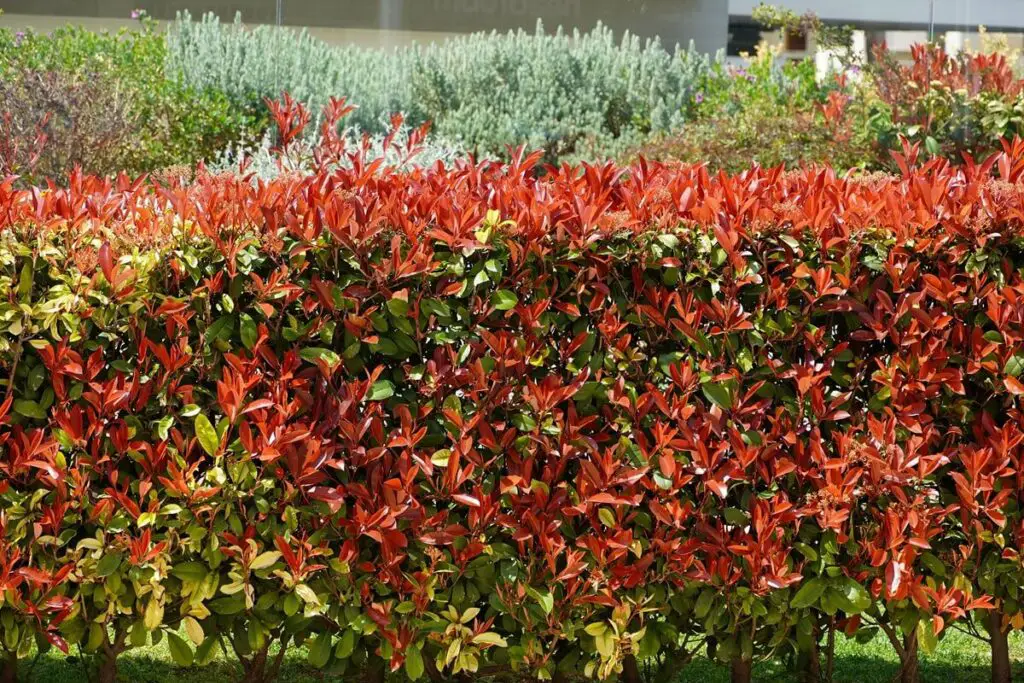
You may not have heard of Photinia but is has some very unique characteristics for an evergreen. For one, it’s rarely green as its red leaves standout as the season progresses. It grows densely and fast and is a hardy plant requiring little maintenance other than pruning.
- Mature Height: 10–20 ft. tall, 5-10 ft. wide
- Special Features: Drought tolerant and can grow in full sun or full shade
- Hardiness Zone Range: Zones 6 to 8
- Maintenance: Low maintenance except for annual pruning
Privacy+
Privacy plus means an added benefit, specifically fruit but also dramatic color. There are many shrubs and bushes that are dense and with enough foliage to offer privacy but also bear fruit at certain times of year, or put on an ever-changing display of color over the seasons.
Better yet, many of these shrubs have thorns which adds a security feature. The only downside is that these shrubs tend to be deciduous so if you’re looking for year-round privacy it will diminish in winter.
Then again, some people plant hedges in parallel rows with one row of evergreens in parallel with a long row of deciduous shrubs that are either aesthetically appealing or have the fruit/thorn benefit. Here are two deciduous shrubs that grow fast and dense while bearing fruits and thorns:
7. Thorny Blackberry (Rubus Watson) – Deciduous
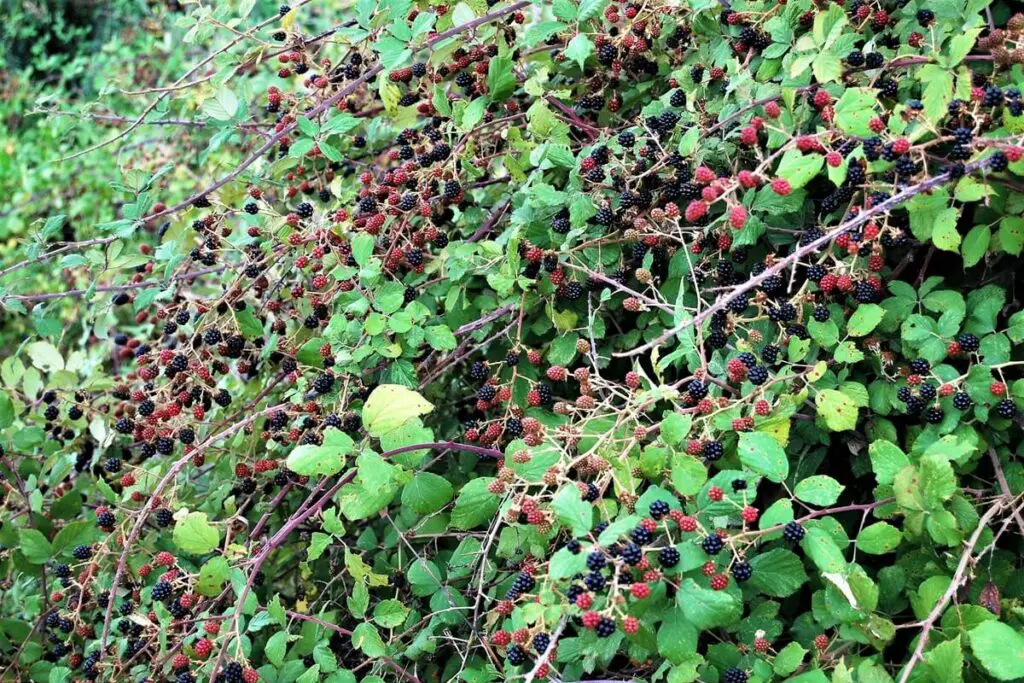
The Thorny Blackberry is a native, wild North American Plant. Most blackberry bushes sold in nurseries are the thornless variety. The most common wild Thorny Blackberry is the Kiowa.
These are not the best shrubs to plant close to your home. The thorns are notoriously sharp. Best planted on the property perimeter and pruning can manage the spread of the plant. A highly effective combination of privacy and security.
- Mature Height: Up to 6 feet high and spreads from 4 to 20 feet.
- Special Features: The thorns are extremely sharp and even a glancing blow can scratch and draw blood. Bears fruit throughout the summer but wear leather gloves and long sleeve shirt when harvesting. Known for its large berries.
- Hardiness Zone Range: Zones 5 to 9
- Maintenance: As an indigenous plant it is extremely hardy. The biggest maintenance chore is pruning and wearing the proper clothing to prevents scratches and punctures.
8. Japanese Barberry (Berberis thunbergii) – Deciduous
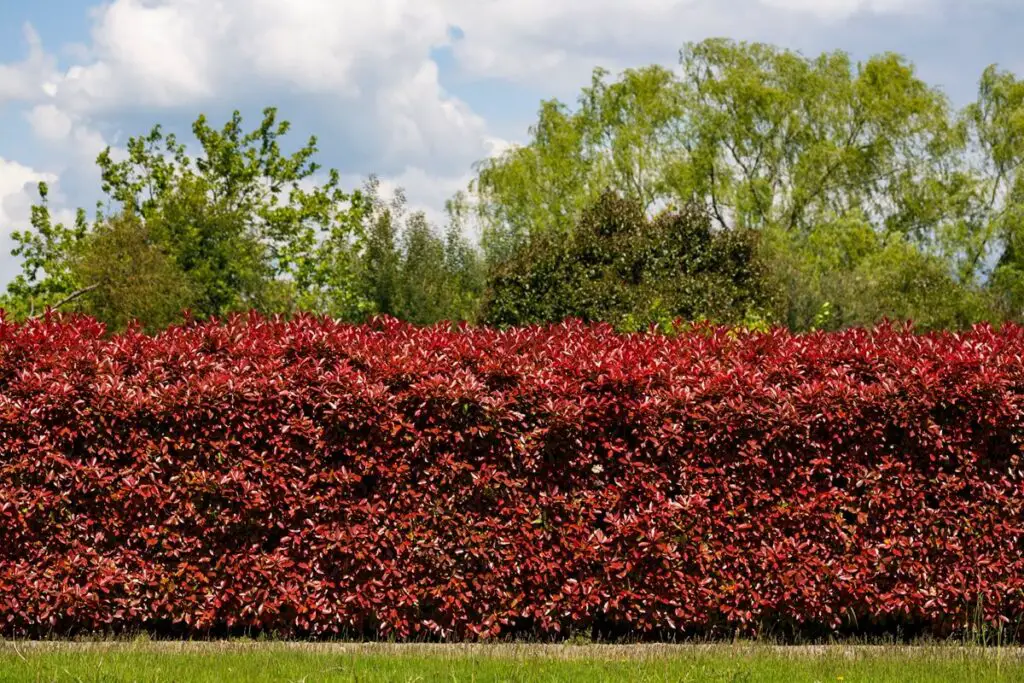
The Japanese Barberry is another shrub that has been traditionally used as both a privacy hedge and for property security. The leaves are a striking combination of reds and the canes have long sharp thorns to discourage trespassers.
It has red berries and the leaves change to varying shades of yellow, orange and red in the fall. It grows about 2 feet a year and blooms in spring with yellow blossoms.
- Mature Height: Up to 6 feet tall and 6 feet wide
- Special Features: Prefers full sun to partial shade and a well drained soil
- Hardiness Zone Range: Zones 4 to 8
- Maintenance: Twice yearly pruning to manage width and shape
General Maintenance
On a basic level, you should make sure any hedgerow of shrubs has enough water and is not showing any signs of stress or disease. There are tree and shrub fertilizer stakes you just pound into the ground that will keep your shrubs fed, and plenty of books on diseases that affect trees and shrubs.
Pruning is also a good idea. You can prune simply to ensure the health and even growth of your shrubs, or you can prune for sharp definition and shapes. Inevitably, some pruning will be necessary to simply keep your natural privacy fence under control.
Something else to keep an eye on are invasive species. If you’re shopping around for your own shrubs, do some research and make sure you don’t plant a shrub that spreads out uncontrollably. You want a manageable height and width and invasive plants don’t play fair.
A special note on feeding: Bushes, shrubs and trees planted for privacy or security are often planted in close proximity in a row. This creates a lot of competition for nutrients from the soil.
Think about how you’ll fertilize your hedgerow from time to time. These fertilizer stakes are one idea, but also be cautious when any bush, shrub, or tree is young. It’s possible to kill it if it is over-fertilized with too much fertilizer or a fertilizer spike driven into the ground too close.
Links to More Resources and Information
This doesn’t have to be rocket science, but if you’re planning an ambitious project using shrubs and even trees for privacy, security or to clearly define your property, do some research. Here are some nurseris, articles, videos, and books that cover the subject fairly well.
Nurseries:
Articles:
- Security Plants for a Safer Home
- 21 Best Privacy Shrubs That Grow Fast
- Create a Living Fence with These 12 Fast-Growing Shrubs for Privacy
Videos:
- A focus on Photinia hedging: All you need to know about Photinia x fraseri ‘Red Robin'
- Fast-Growing Shrubs and Bushes for Creating Privacy
Books:
- Easy How-To Grow Trees for Privacy Screens and Windbreaks: 10 Fast Growing Trees You Should Plant
- Landscaping for Privacy: Innovative Ways to Turn Your Outdoor Space into a Peaceful Retreat
Like this post? Don't Forget to Pin It On Pinterest!
You May Also Like:

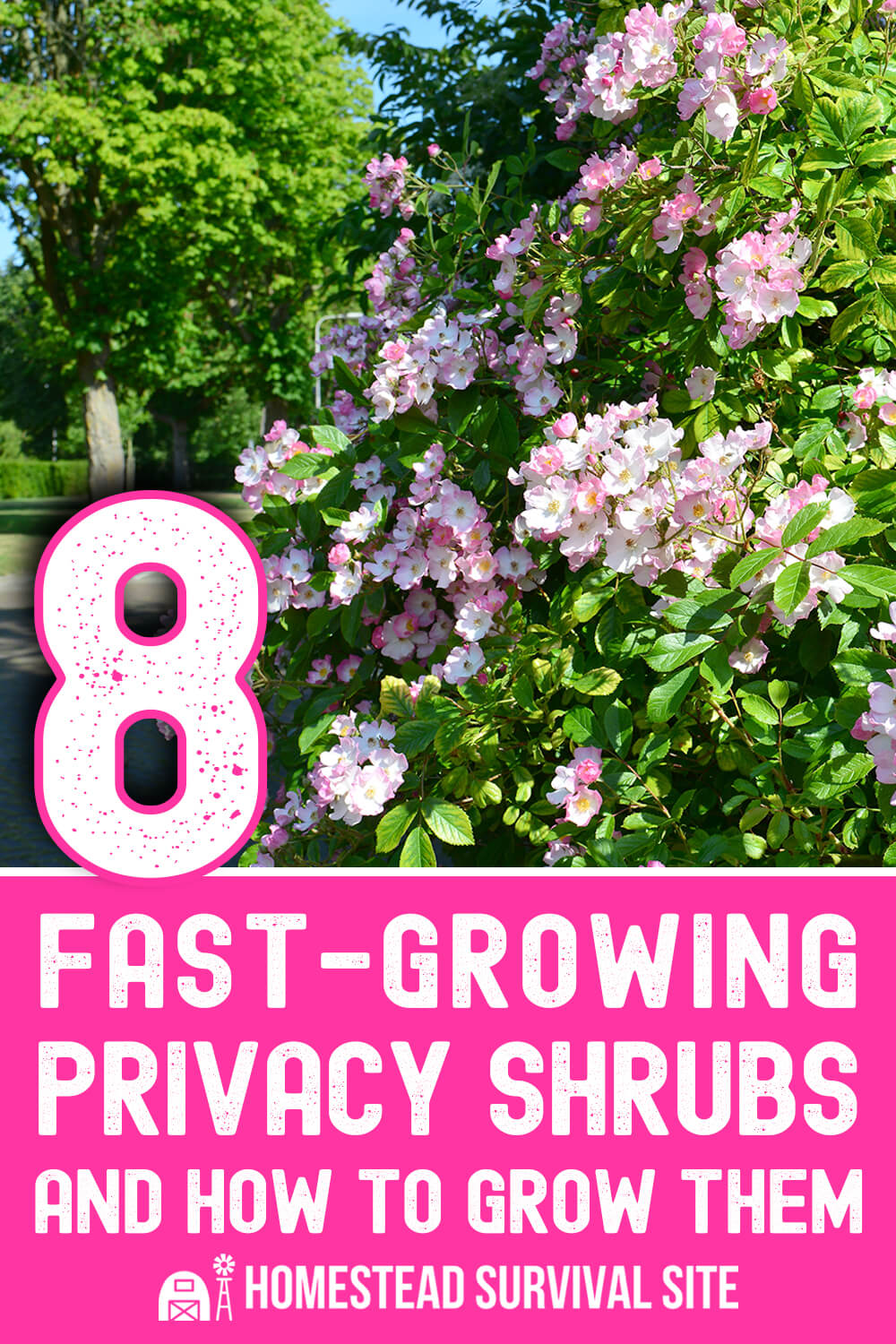


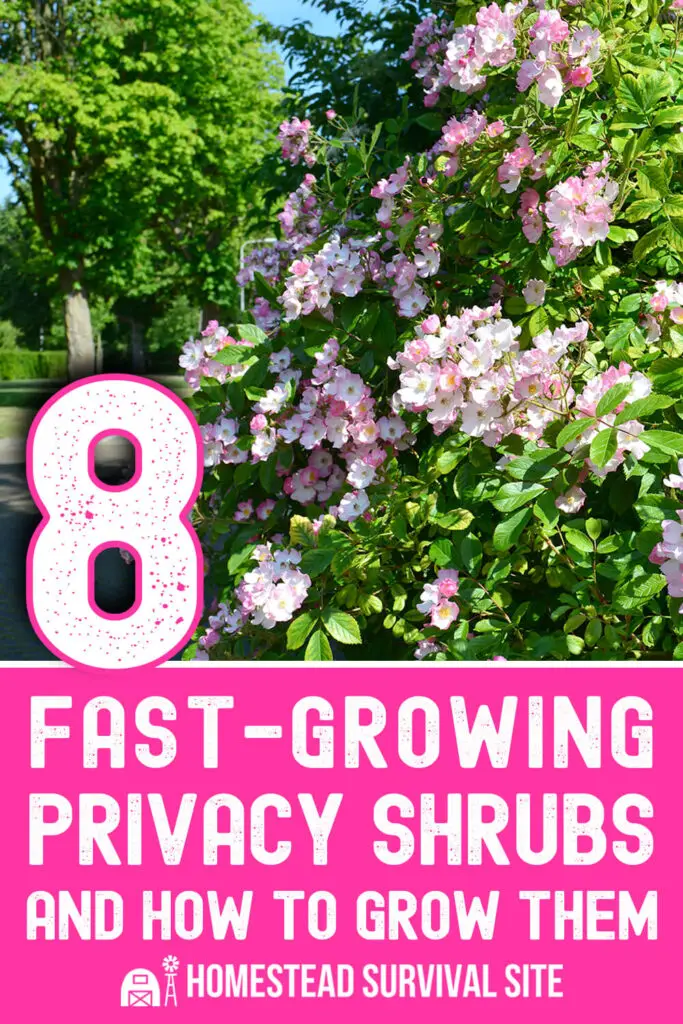








Burning
Bush and barberry are considered in Invasive in Wisconsin.